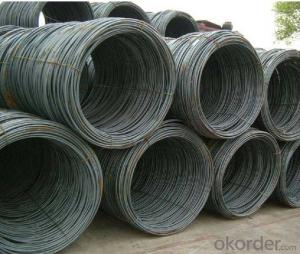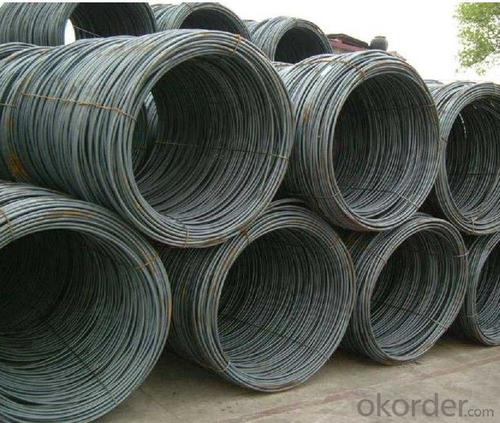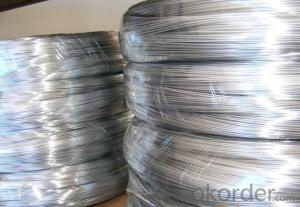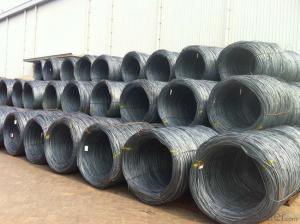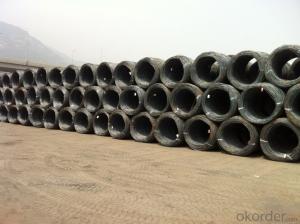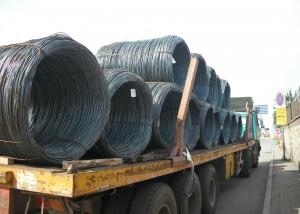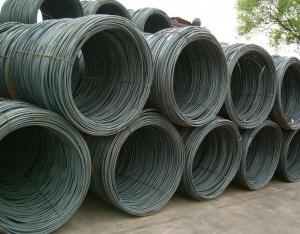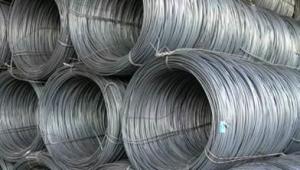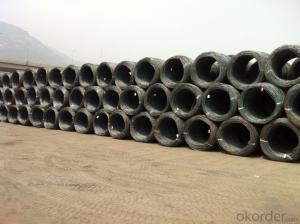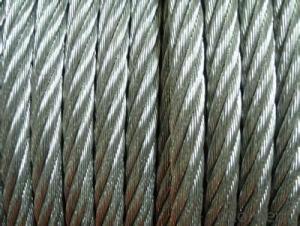American Standard Wire Rod
- Loading Port:
- China Main Port
- Payment Terms:
- TT OR LC
- Min Order Qty:
- -
- Supply Capability:
- -
OKorder Service Pledge
OKorder Financial Service
You Might Also Like
Specifications of Steel Wire Rod in Coil:
Steel Grade: Q195/235, SAE1006-1018B Standard: ASTM, GB
Diameter: 6.5mm
Type: Drawn Wire Alloy or Not: Alloy
Technique: Hot Rolled
Usage and Applications of Hot Rolled Wire Rod:
After hotrolled the products shaped into coil and delivery as finished product, including round, square, rectangular, hexagonal and so on. Since most of the products are round, it is generally called wire rod. Carbon steel wire rod is widely used in construction and manufacturing. Carbon steel wire rod is mainly used for reinforcement of reinforced concrete and welded structure or reprocessed (roberts , nail, etc.) materials, especially used to produce wire drawing, welding electrode, nails, spring, electronic, precise machinery parts and so on.
Packaging & Delivery of Hot Rolled Wire Rod:
Packaging Detail: products are packed in coil, each coil weight around 2 MT, and then shipped by container or bulk vessel
Delivery Detail: within 45 days after received deposit or LC.
Label: to be specified by customer, generally, each bundle has 1-2 labels
Trade terms: FOB, CFR, CIF
Note:
1. Our products are produced according to national standard (GB), if not, supply according to national standards (GB) or agreement as customer required.
2. Other Grade and Standard carbon steel wire rod we can supply:
Grade: H08A, 30MnSi, 62B-82B
Standard: AISI, BS, JIS, DIN
The Minimum Order Quantity of these products is high, and need to be confirmed.
3. We can not only supply carbon steel wire rod; if you need anything about building materials, please contact us.
4. Please send us your detail specifications when inquire. We will reply to you as soon as possible. We sincerely hope we can establish a long stable business relationship.
- Q: What are the common packaging options for steel wire rod?
- The common packaging options for steel wire rod include coils, bundles, and wooden or steel pallets.
- Q: How is steel wire rod used in the manufacturing of window and door frames?
- Steel wire rod is commonly used in the manufacturing of window and door frames due to its strength and durability. The steel wire rod is typically used as a reinforcement material to provide structural support and stability to the frames. During the manufacturing process, the steel wire rod is first subjected to a series of mechanical and chemical treatments to enhance its strength and resistance to corrosion. This process involves cleaning, descaling, and coating the wire rod to ensure its suitability for use in window and door frames. Once the steel wire rod is prepared, it is then shaped and formed into the desired frame structure. This can be done through various techniques such as bending, welding, or using specialized machinery to mold the wire rod into the required shape and size. The steel wire rod is then integrated into the window or door frame structure, typically by being welded or fastened together with other components. This helps to improve the overall strength and stability of the frame, ensuring that it can withstand the weight and pressure exerted on it. Additionally, the use of steel wire rod in window and door frames provides added security and resistance against break-ins. The high tensile strength of the steel wire rod makes it difficult to bend or break, making it a reliable material for ensuring the safety of residential or commercial premises. Overall, the use of steel wire rod in the manufacturing of window and door frames offers numerous benefits, including increased strength, durability, and security. It ensures that the frames can withstand the test of time, provide structural integrity, and enhance the aesthetic appeal of any building.
- Q: What are the different high-temperature properties of steel wire rod?
- Various applications can benefit from the suitability of steel wire rods due to their multiple high-temperature properties. Among these properties, high thermal stability stands out as a key feature. It enables the wire rods to maintain their structural integrity even when exposed to elevated temperatures. This characteristic is crucial in industries like automotive and aerospace, where parts made of steel wire rods endure high temperatures during operation. Another significant property of steel wire rods at high temperatures is their resistance to oxidation. To protect against corrosion, these wire rods are usually coated with a layer of zinc or galvanized coating. This protective layer acts as a barrier, preserving the wire rods' strength and preventing them from corroding when subjected to harsh environments and high temperatures. Furthermore, steel wire rods exhibit exceptional mechanical properties at elevated temperatures. They possess high tensile strength and good resistance to creep, allowing them to endure heavy loads and prolonged exposure to high temperatures without deforming or breaking. These characteristics make them an ideal choice for industries such as construction and manufacturing, where strength and durability are essential. Moreover, steel wire rods also exhibit good thermal conductivity, enabling efficient heat transfer. This property proves beneficial in applications like heating elements, where the wire rods are utilized to generate and distribute heat evenly. In conclusion, the various high-temperature properties of steel wire rods, including thermal stability, resistance to oxidation, excellent mechanical properties, and good thermal conductivity, make them a versatile and dependable material for numerous high-temperature applications across various industries.
- Q: What are the common production processes for plutonium-coated steel wire rod?
- The common production processes for plutonium-coated steel wire rod include cleaning and preparing the steel wire, applying a thin layer of plutonium coating using techniques like electroplating or physical vapor deposition, and then ensuring the proper adhesion and quality of the coating through processes like heat treatment and testing.
- Q: What are the different methods of joining steel wire rod?
- Different methods can be used to join steel wire rods, each having its own advantages and disadvantages. Some commonly used methods include welding, soldering, brazing, and mechanical joining. 1. Welding is the most popular method for joining steel wire rods. It involves melting the ends of the rods together using high temperatures and filling the gap with molten filler metal. Welding creates a strong and permanent bond, but it requires skilled labor and specialized equipment. 2. Soldering, on the other hand, uses a lower melting point filler metal called solder to join the steel wire rods. This method is often used for smaller diameter wires and provides a relatively strong joint. However, soldered joints may not be as strong as welded joints and can be affected by high temperatures. 3. Brazing is similar to soldering, but it uses a filler metal with a higher melting point. The filler metal is heated to its melting point, below the melting point of the base metal, and then allowed to flow between the rods. Brazing produces a stronger joint than soldering and can be used for higher temperature applications. 4. Mechanical joining involves connecting the steel wire rods without heat or filler metals. It can be done using various techniques such as crimping, swaging, or using nuts and bolts. Mechanical joining is often easier and faster than other methods, but it may not provide the same level of strength or permanence. When selecting the appropriate method for joining steel wire rods, it is important to consider the specific requirements of the application, such as strength, temperature resistance, and ease of assembly. Additionally, factors like cost, availability of equipment, and expertise required should also be taken into account.
- Q: How is steel wire rod used in the manufacturing of wire rope rings?
- Steel wire rod is used as the primary raw material in the manufacturing of wire rope rings. It is first drawn into a wire of the required diameter and then twisted into strands. These strands are then helically wrapped around a core to form a wire rope, which is subsequently shaped into rings. The high strength and durability of steel wire rod make it an ideal material for wire rope rings, providing them with the necessary load-bearing capacity and resistance to wear and tear.
- Q: How are steel wire rods used in the manufacturing of bicycle spokes for strength and flexibility?
- Steel wire rods are an essential component in the manufacturing process of bicycle spokes, as they provide the necessary strength and flexibility required for optimal performance. The use of steel wire rods ensures that the spokes can withstand the various forces and stresses experienced during cycling, such as the weight of the rider and impacts from uneven surfaces. The strength of steel wire rods is crucial in bicycle spokes as they need to bear the weight of the rider and transfer the force from pedaling to the wheels. Steel is known for its high tensile strength, meaning it can resist large amounts of pulling or stretching forces without breaking. This property makes it ideal for bicycle spokes, which need to support the weight of the rider and maintain stability. Furthermore, steel wire rods offer excellent flexibility, allowing the spokes to absorb and distribute external forces evenly. This flexibility helps to absorb shocks and vibrations, reducing the impact on the bicycle's overall structure and enhancing the comfort of the rider. Manufacturers typically shape the steel wire rods into a specific profile to optimize strength and flexibility. The rods are often cold-drawn, a process that increases their tensile strength while maintaining their flexibility. Cold-drawn steel wire rods are strong enough to withstand the forces applied during cycling, yet they retain enough flexibility to allow the spokes to move and adjust to various road conditions. In summary, steel wire rods play a vital role in the manufacturing of bicycle spokes for strength and flexibility. Their high tensile strength ensures the spokes can bear the weight of the rider and transfer forces effectively, while their flexibility helps absorb shocks and vibrations. Overall, steel wire rods provide the necessary durability and performance required for spokes in bicycle manufacturing.
- Q: How is the ductility of steel wire rod evaluated?
- The ductility of steel wire rod is typically evaluated by conducting a tensile test, where a sample of the wire rod is subjected to an increasing load until it eventually breaks. The extent to which the wire rod can be stretched and elongated before fracture provides an indication of its ductility.
- Q: How is steel wire rod used in the manufacturing of wire containers?
- Steel wire rod is used in the manufacturing of wire containers as it serves as the main raw material for forming the wire mesh that creates the structure of the container. The steel wire rods are processed through various manufacturing techniques such as drawing, annealing, and galvanizing to create strong and durable wires. These wires are then woven or welded together to form the mesh panels of wire containers, providing the necessary strength and stability for holding and transporting various goods and materials.
- Q: How is steel wire rod used in the manufacturing of wire for electrical grounding systems?
- Steel wire rod is a vital part of the wire manufacturing process for electrical grounding systems. These systems are crucial in keeping electrical installations safe and functional by providing a pathway for electrical currents to flow into the ground, preventing damage or shocks. To shape and form the steel wire rods, they undergo a series of operations. Typically, the wire rods are drawn through dies to reduce their diameter and achieve the desired thickness. This drawing process strengthens the wire and ensures consistent dimensions. High-quality carbon or stainless steel is commonly used for the steel wire rods in electrical grounding systems to ensure durability and resistance to corrosion. Once the steel wire rods are drawn to the desired size, they undergo various surface treatments. Galvanization is a common treatment where the wire is coated with zinc to improve corrosion resistance and electrical conductivity for better grounding efficiency. After the surface treatment, the wire is cut to specific lengths and spooled onto reels or coils. These wire coils are then used to manufacture grounding cables, conductors, or earth electrodes for electrical grounding systems. The steel wire provides strength and stability to the grounding system as a core component. The wire made from steel wire rod is versatile and can be used in various electrical grounding applications, from residential and commercial buildings to industrial facilities. It is commonly used to ground electrical equipment, machinery, and infrastructure, ensuring the safe dissipation of electrical currents. In conclusion, steel wire rod is a fundamental material in the production of wire for electrical grounding systems. Its strength, durability, and resistance to corrosion make it an ideal choice for ensuring the safety and functionality of electrical installations.
Send your message to us
American Standard Wire Rod
- Loading Port:
- China Main Port
- Payment Terms:
- TT OR LC
- Min Order Qty:
- -
- Supply Capability:
- -
OKorder Service Pledge
OKorder Financial Service
Similar products
Hot products
Hot Searches
Related keywords
